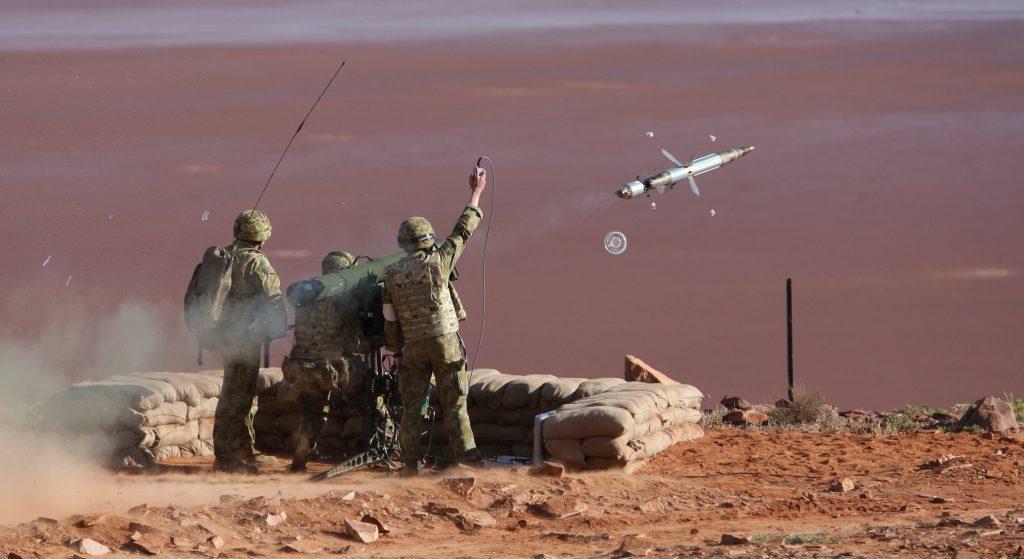NASAMS and Australian forward force protection
Posted By Adam Cabot on July 12, 2017 @ 11:00

Australia’s only ground-based air defence is the dated RBS-70 [1] short-range Man Portable Air Defence System (MANPAD). This system is utilised by the Australian Army and relies on laser guidance to strike the target. In effect, this means that the operator must keep the weapon’s sights trained on the target aircraft until the missile scores a hit. For the soldier employing the weapon system in a battlefield environment there are obvious dangers as he or she becomes a prime target for enemy fire.
The Australian government has recently approved a single supplier limited request for tender to Raytheon to develop the National Advanced Surface-to-Air Missile System (NASAMS) [2] for use by the Australian Army to replace the RBS-70. It’s possible that this system may use the Hawkei vehicle as a launch platform [3] and be armed with the AMRAAM [4] which is a ‘fire and forget’ missile using radar guidance with an increased range over the RBS-70. This will provide forward deployed troops with a highly mobile and effective ground based air defence system and limit the effectiveness of enemy close air support such as low flying fixed wing aircraft and helicopters and intelligence gathering unmanned aerial vehicles.
A further consideration for this project is the collaboration between Raytheon and local company, CEA Technologies, to integrate a land based version of their Phased Array Radar with NASAMS. CEA Technologies has already incorporated a Phased Array Radar into four ANZAC-class Frigates [5] and the Ground Based Multi Mission Radar (GBMMR) version is capable of being mounted on a large truck. According to the 2016 Defence White Paper [6], an RBS-70 replacement will enter service by the early 2020s.
The media interest regarding ADF procurement in recent years has centred largely on the Collins replacement program, the F-35 Joint Strike Fighter and the Hobart-class Air Warfare Destroyers. These are all very important systems but it’s crucial not to overlook the immense value and advantage that NASAMS will provide to our forward deployment capability. It will be a big leap forward for the Australian Army, as it provides another layer-to-air defence capabilities in an age where air superiority is the key to success in many strategic and tactical scenarios.
History is littered with examples of Surface to Air Missiles (SAMs) impacting on a battlefield environment. One that springs to mind that has hopefully been studied by those involved in the potential procurement of NASAMS is the 1973 Yom Kippur War. Egypt learnt valuable lessons from the 1967 Six-Day War [7] where Israeli air superiority destroyed the Egyptian air force on the ground and provided close air support [8] throughout the conflict.
As a result of this experience, Egypt built a layered ground-based air defence system utilising SAMs purchased from the Soviet Union such as the SA-2, SA-3 and the highly mobile SA-6 Kub. This integrated network was highly effective in disrupting Israeli airstrikes, severely limiting the ability of the Israeli Air Force (IAF) to conduct low-level strafing attacks. A declassified CIA publication [9] showed that the effectiveness of the Egyptian ground based air defence system during the conflict is measured by disruption rather than the quantity of aircraft shot down. The IAF was unable to deploy its close air support effectively while Egyptian forces were protected by the air defence umbrella.
Mounting the NASAMS on the Hawkei will provide a mobile air defence capability which is critical for survivability as the system can conduct fire and movement operations limiting enemy target opportunities as well as the ability to move with ground forces as it advances or retreats to maintain coverage within the air defence umbrella. Potential limitations are that the Hawkei is a four-wheeled platform which could struggle in some terrain. It will lack an inbuilt radar, forcing it to rely on an independent radar separate from the launch vehicle for locating and tracking enemy aircraft. If that radar is lost or is unable to cover the mobile field of operations, the air defence capability will be rendered useless. The Soviets learnt this lesson very early and developed the Buk system [10] where each tracked vehicle or TELAR consists of its own independent radar so that it can operate autonomously if need be.
Upgrading the Australian Army’s ground-based air defence capability is an example of sound strategic thinking by the ADF. The benefits of employing this system for the safety and the ability for our troops to act more independently in a hostile environment cannot be overstated. The government deserves credit for modernising Australia’s integrated air defence network.
Article printed from The Strategist: https://aspistrategist.ru
URL to article: /nasams-australian-forward-force-protection/
URLs in this post:
[1] RBS-70: http://www.army-technology.com/projects/rbs70/
[2] (NASAMS): http://www.janes.com/article/69475/nasams-selected-for-australian-army-gbad-system
[3] Hawkei vehicle as a launch platform: http://www.australiandefence.com.au/news/2-billion-for-nasams-gbad-system
[4] AMRAAM: http://www.raytheon.com.au/capabilities/products/nasams/
[5] four ANZAC-class Frigates: http://www.smh.com.au/national/defence-white-paper-will-reboot-relationship-with-industry-minister-payne-says-20160205-gmmjuy.html
[6] 2016 Defence White Paper: http://www.defence.gov.au/whitepaper/Docs/2016-Defence-White-Paper.pdf
[7] Egypt learnt valuable lessons from the 1967 Six-Day War: http://www.dtic.mil/dtic/tr/fulltext/u2/a186417.pdf
[8] close air support: http://www.jewishvirtuallibrary.org/israel-air-force-in-the-six-day-war
[9] CIA publication: https://www.cia.gov/library/readingroom/docs/1975-09-01A.pdf
[10] Buk system: http://www.military-today.com/missiles/buk.htm
Click here to print.